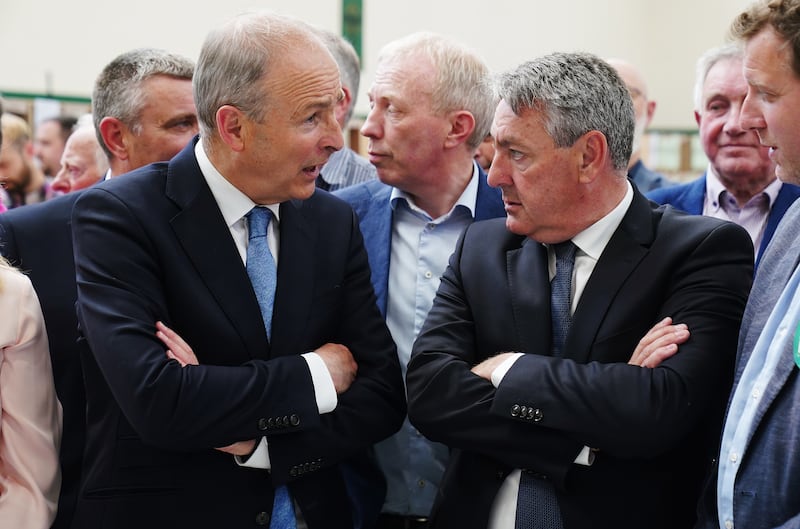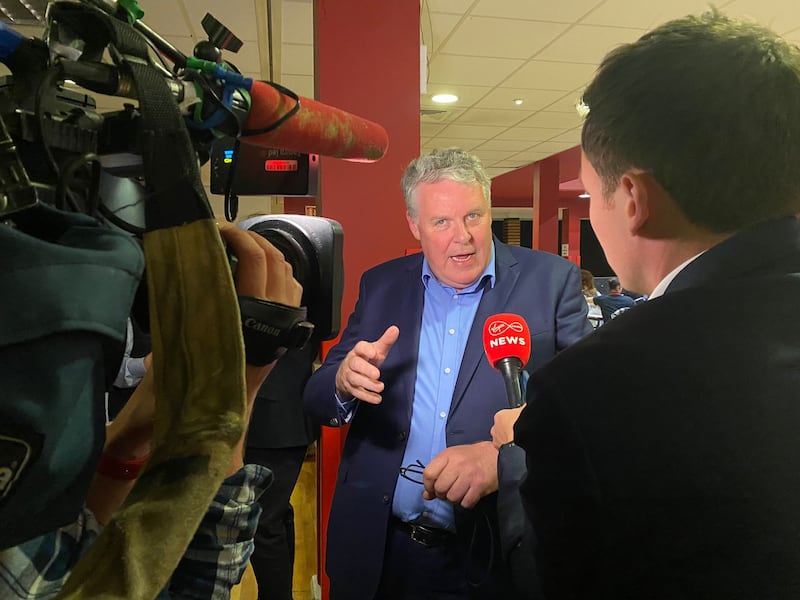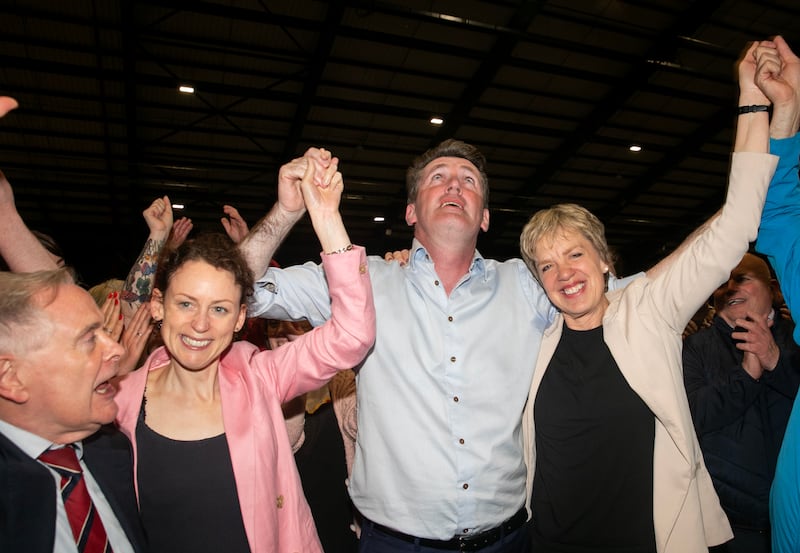There was a time, not so long ago, when elections in Ireland tended to be relatively predictable. The outcome might be unknown and the margins tight. But nobody expected dramatic swings in any direction.
Well, not any more.
The last five national elections – the locals and Euros in 2014 and 2019; the general elections of 2011, 2016 and 2020 – all produced big and largely unanticipated shifts in the political landscape. Last weekend’s elections, the 2024 locals and Euros, followed the pattern.
The new first rule of Irish elections is now clear: expect the unexpected.
READ MORE
Victims of the volatility this time were Sinn Féin, spectacularly so. True, support for the party has been falling in recent months; the polls were pretty clear on that. But the slide turned into a nosedive during the election campaign, leaving the party with just 12 per cent of the vote in the local elections, and 11 per cent in the European elections. For a party that has coasted above 30 per cent for much of the last three years, this is nothing short of a disaster.
For a long time, Sinn Féin enjoyed the support of nearly as many voters as Fianna Fáil and Fine Gael combined; now they have barely half of what each of the others do. It’s some turnaround.
But if volatility is the new norm, resilience is now the essential quality in political organisations; the ability to bounce back from adversity will be required sooner or later. The parties that triumphed in recent days have all had bleak days in the recent past; some have had many.
Shinners are not winners
Sinn Féin, along with everyone else, knew that it was headed for a difficult election, as its poll ratings tumbled steadily in recent months. But nobody knew it was going to be this bad. There hasn’t been a collapse like it since the cratering of Fianna Fáil’s vote in the middle of the financial crisis.
At the count centre in the RDS, Mary Lou McDonald looked shell-shocked.
[ Sinn Féin falls flat in hugely ambitious local election strategyOpens in new window ]
“Does she always arrive surrounded like that?” asked one onlooker in the vast Simmonscourt pavilion as the Sinn Féin leader arrived, insulated from the throngs of reporters, in the middle of a defensive phalanx of supporters and protectors.
They couldn’t deflect the inevitable questions. McDonald is now a leader under extreme internal and external pressure. The unhappiness in the organisation is evident for all to see. How could it be otherwise? If she cannot deliver government after the next election, it’s hard to see the party sticking with her. But there’s no roadmap for that kind of thing in Sinn Féin.
Some of the party’s army of online supporters – the “Shinnerbots” who push the party’s narrative on social media and monster anyone who dares to criticise the party – tried to point out that Sinn Féin had actually gained seats since 2019, while Fine Gael and Fianna Fáil have lost seats. This is true. But most of the Shinnerbots didn’t even bother. Maybe they were told to shut up for now. Maybe they figured out nobody would buy it.
In fairness to her, McDonald tried to mount a defence; she didn’t shirk the interviews. She’s tough. But her party is in deep trouble. And her analysis that Sinn Féin did badly because people are angry at the Government is not one that is likely to bear much scrutiny.
Figuring out what went wrong is something that will take some time, some honesty and some painful self-reflection for the party. The emergence of councillors willing to criticise the party leadership on the record is a departure; more party figures are willing to do it in private. This is more evidence that Sinn Féin’s progress towards the mainstream continues.
But will that move to the centre continue?
One of the schools of thought emerging in the party is that it was indistinguishable from the Government parties; so eager was the party to portray itself as the government-in-waiting that it ended up looking like the actual Government. Those who believe this want to adopt a more radical stance.
But whether the party can do that credibly is another question entirely. If you have abandoned radical positions to move to the centre in preparation for government, voters might be sceptical of a sudden lurch back to radical positions. It might begin to look like you were willing to say anything in order to be elected.
A more viable response, perhaps, is to find a middle way – presenting a credible alternative government that has radical prescriptions to address the problems people see everywhere. That’s a hard path to find, though, and harder to walk.
The centre holds
The big winners, much as it annoys their many critics, were undoubtedly Fine Gael and Fianna Fáil.
After four years of relentless pressure from Sinn Féin and the remainder of the Opposition, both the main Government parties held their own, minimising losses from the relatively high level of the last local elections in 2019. That was a solid performance. What makes it a thrilling result for them is the decline of their chief rival.
The centre held. If you have detected a tinge of hubris in recent days, that’s hardly unexpected. But they would do well to stamp it out quickly. The volatility witnessed in these elections could turn against them as quickly as it turned in their favour. Both will now be closely analysing the results to see what they mean for the general election prospects in the various constituencies.

More generally, what the results do is demonstrate what those closely interrogating the polls have known for some time, even before the Sinn Féin collapse: that the current Government, or something like it, can be returned after the next general election.
Even when Sinn Féin was cruising in the mid-30s in the polls last year, support for the Government parties never completely collapsed. At the last general election in 2020, the three parties won an aggregate vote of about 50 per cent; in these local elections, it stood at 49.5 per cent. The Greens are certainly hurting after a tough day out, but they haven’t been wiped out.
The truth is that Fianna Fáil and Fine Gael now expect to form the next Government. It is not certain that the Greens will be with them; but the big two expect to have other options anyway – Independents, Labour, the Social Democrats, maybe. Everyone should be warned that general elections are different from locals and Euros. Nonetheless, the political outlook has been transformed.
Independents’ day
From early on Saturday, it was clear that there was a wave of support heading to Independent candidates and micro-parties. In the local elections, they won 28 per cent; in the Euros, a whopping 35 per cent.
Counted together, they would be the largest political group in the country by some distance. But, of course, it makes no sense to consider them as one political group.
How many types of Independents are there? As many as you want. There is the sort of Independents who have long been a fixture in Irish politics – many of them are formerly members of political parties who have gone their own way for whatever reason. They range from right to left and can be found at all points in between. Some of them – such as the Lowrys in Tipperary, the Healy-Raes in Kerry and Verona Murphy’s Wexford Independent Alliance – are grouping together in mini-parties to maximise their influence.
Then there is the new Independent Ireland party, led by Cork South West Independent TD Michael Collins, which is poised to take a seat in Midlands-North West, one of the three Euro constituencies through the former RTÉ reporter Ciaran Mullooly, as well as 23 local authority seats around the country. It is trying to be both a party and a group of Independents at the same time – a balancing act it will be able to manage until such time as it has to take positions on issues that its members disagree on, or until it seeks to become part of a government.

These elections also threw up a new type of Independent and micro-party: a far-right fringe which campaigns against migration into the country. There is a fair distinction to be drawn between the far-right, Ireland-for-the-Irish brigade and those candidates who are not virulently anti-migration as such but who questioned the location of individual facilities for asylum seekers in their areas. Of course, they can sometimes cross over into each other. The far right had limited success in electing councillors – no more than a handful, maybe five, properly fit the definition. But some of their European candidates – such as Derek Blighe in Ireland South – racked up a lot of votes before they were eliminated.
“I think it’s a fabulous result for the nationalist movement in Ireland,” said Malachy Steenson, the anti-immigrant campaigner elected to Dublin City Council for the North Inner City. “It’s a fabulous result for the people of Ireland. We’re taking our nation back ... it’s a clear message the revolution has begun.”
[ Number of Independents doubles in 15 years as public tire of traditional partiesOpens in new window ]
Well, no it hasn’t. But the truth is the far right now has a toehold in Irish electoral politics. More broadly, migration and its challenges are a central issue in politics now.
But it’s also worth adding: these elections have seen the election of record numbers of candidates from a migrant background. More than 100 candidates from a migrant background ran and 21 were elected. Even as some voters feel threatened by and hostile to those who look and sound different from them, many more are prepared to put their trust in these candidates as their representatives.
Labour shows life
The party has not been a meaningful force in Irish politics for a long time but, with these elections, that showed signs of changing, especially if it can co-operate with other parties of the centre-left to form a bloc in the next Dáil. But probably the biggest change for Labour members wasn’t in the numbers: it was in the way they felt. The party rediscovered optimism.
Much of that is down to the forceful candidacy of Aodhán Ó Ríordáin for the European Parliament in Dublin. Months ago Ó Ríordain had little enthusiasm for the idea of going to Brussels but was convinced that the emerging leadership proposal to run Senator Annie Hoey was a recipe for sub-5 per cent irrelevance. He insisted on a convention and won it.

Early polls signalling that he had a chance confirmed the assessment that there would be a soft-left seat and that he could take it; it would come down to him or the Green Party’s Ciaran Cuffe. And so it was to prove: Cuffe’s elimination paved the way for Ó Ríordáin’s victory over immigration sceptic and radio shock jock Niall Boylan of Independent Ireland.
At the count centre in the RDS in Dublin on Tuesday evening, as the inevitability of Ó Ríordáin’s victory dawned on them, the Labour contingent didn’t quite know what to say. More than a few wondered if losing Ó Ríordáin to Brussels was really the best outcome.
“Maybe we’d be better off coming fifth,” mused one, half seriously.
But winning elections is never bad strategy for a political party trying to claw its way back to government. The victorious candidate himself was by turns elated and bemused.
“It’s like an out-of-body experience,” he told reporters. It would be rather too much to declare Labour is back. But the party has taken a great step back towards relevance.
- Sign up for push alerts and have the best news, analysis and comment delivered directly to your phone
- Join The Irish Times on WhatsApp and stay up to date
- Listen to our Inside Politics podcast for the best political chat and analysis














